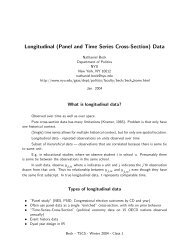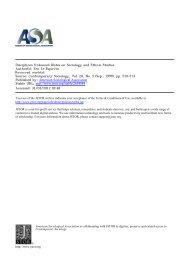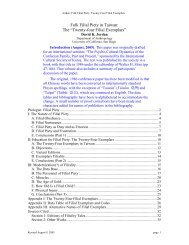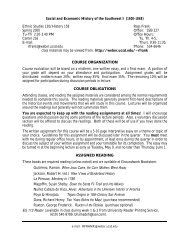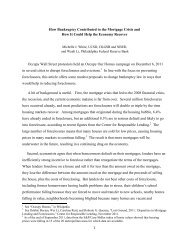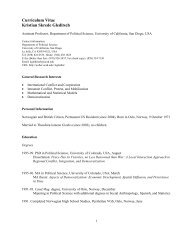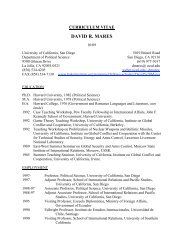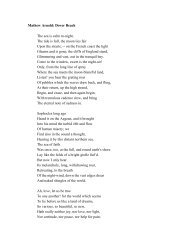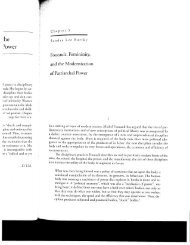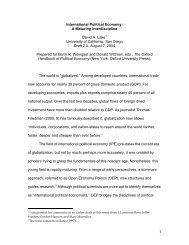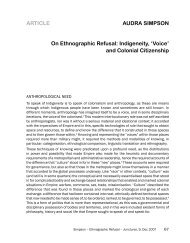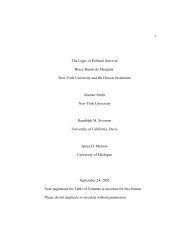Climate change and water resources in the Murray Darling Basin ...
Climate change and water resources in the Murray Darling Basin ...
Climate change and water resources in the Murray Darling Basin ...
You also want an ePaper? Increase the reach of your titles
YUMPU automatically turns print PDFs into web optimized ePapers that Google loves.
ABARE CONFERENCE PAPER 02.11<br />
areas <strong>the</strong> opportunity cost of <strong>water</strong> was assumed to be considerably higher at $70 <strong>and</strong> $150<br />
a megalitre respectively.<br />
Initial values for <strong>the</strong> production function coefficients for each activity were <strong>the</strong>n determ<strong>in</strong>ed<br />
as:<br />
RentLj<br />
α Lj(<br />
0)<br />
=<br />
RentTotalj<br />
RentSWj<br />
(10)<br />
α swj(<br />
0)<br />
=<br />
RentTotalj<br />
RentGWj<br />
α gwj(<br />
0)<br />
=<br />
RentTotal<br />
j<br />
1−αLj ( 0) −αswj ( 0) −αgwj<br />
( 0)<br />
j = j( 0) j( 0) j(<br />
0)<br />
A L sw gw<br />
With<strong>in</strong> a simulation, <strong>the</strong>se coefficients are adjusted from <strong>the</strong> <strong>in</strong>itial values accord<strong>in</strong>g to<br />
equation (6). The coefficients <strong>in</strong> equation (6) were derived from estimated yield losses<br />
caused by irrigation sal<strong>in</strong>ity (MDBC 1999).<br />
The <strong>Murray</strong> Darl<strong>in</strong>g Bas<strong>in</strong> Commission has l<strong>in</strong>ked its hydrological model<strong>in</strong>g to estimates<br />
of cost impacts based on <strong>in</strong>cremental <strong>in</strong>creases <strong>in</strong> sal<strong>in</strong>ity. Costs downstream of Morgan are<br />
imputed as a function of EC <strong>change</strong>s <strong>in</strong> salt concentration at Morgan. The analysis considers<br />
agricultural, domestic <strong>and</strong> <strong>in</strong>dustrial <strong>water</strong> uses. Us<strong>in</strong>g <strong>the</strong> cost functions derived <strong>in</strong><br />
this model, each unit <strong>in</strong>crease <strong>in</strong> EC at Morgan is imputed to have a downstream cost of<br />
$173 450 (Doug Young, Primary Resources South Australia, personal communication,<br />
January 2002). This cost is <strong>in</strong>cluded <strong>in</strong> <strong>the</strong> analysis presented here.<br />
Changes <strong>in</strong> annual average precipitation <strong>and</strong> potential evaporation were estimated for <strong>the</strong><br />
SRES climate <strong>change</strong> scenarios us<strong>in</strong>g <strong>the</strong> scenario generator OZCLIM version 2.0.1.<br />
Changes <strong>in</strong> <strong>the</strong>se variables were estimated as percentage <strong>change</strong>s from <strong>the</strong> base year 1995<br />
for <strong>the</strong> years 2020, 2050 <strong>and</strong> 2100. The <strong>in</strong>terven<strong>in</strong>g years were l<strong>in</strong>early <strong>in</strong>terpolated. The<br />
output generated by OZCLIM was <strong>the</strong>n translated <strong>in</strong>to a GIS po<strong>in</strong>t coverage us<strong>in</strong>g ArcInfo.<br />
Precipitation <strong>and</strong> potential evaporation data were extracted for each <strong>the</strong> l<strong>and</strong> management<br />
unit <strong>in</strong> <strong>the</strong> SALSA model us<strong>in</strong>g ArcView3.1. These data were <strong>in</strong>corporated <strong>in</strong>to <strong>the</strong> hydrological<br />
component of <strong>the</strong> model<strong>in</strong>g framework described previously.<br />
Reductions <strong>in</strong> precipitation are projection for both <strong>the</strong> A1 <strong>and</strong> B1 scenarios. In isolation, this<br />
would be expected to <strong>in</strong>crease irrigation <strong>water</strong> requirements <strong>and</strong> reduce dryl<strong>and</strong> yield. At<br />
<strong>the</strong> same time, <strong>in</strong>creased concentrations of atmospheric carbon dioxide, are likely to result<br />
<strong>in</strong> greater <strong>water</strong> use efficiency by plants. The extent to which one of <strong>the</strong>se offsett<strong>in</strong>g factors<br />
will dom<strong>in</strong>ate is highly uncerta<strong>in</strong>. In <strong>the</strong> analysis presented here it was assumed that dryl<strong>and</strong><br />
crop yields are unaffected by global warm<strong>in</strong>g.<br />
19




